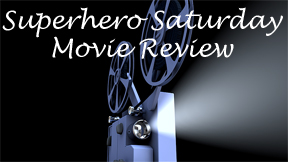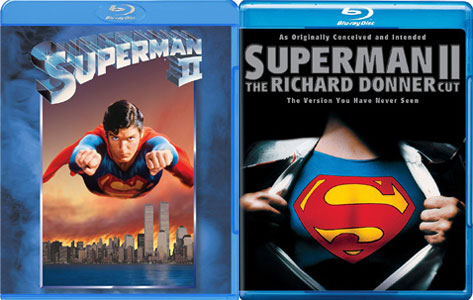“Superman II” (1981) has always been a beloved film, but when an alternate version came out in 2006, it became even more beloved. The theatrical Richard Lester Cut rates a 6.8 on IMDB and the newer Richard Donner Cut rates a 7.7. That’s not a trivial gap. But in my opinion the difference in quality between the two films is minor, and upon a close analysis, I’d argue the Lester Cut is slightly superior.
Some caveats should be made here. If Donner (working from a screenplay with more of Tom Mankiewicz’s material) had been allowed by producers Alexander and Ilya Salkind to direct the whole film and exercise his vision, the result would not precisely be the Donner Cut.
This 2006 version is as close to his vision as possible when working from the footage that was available, and by necessity it includes many sequences directed by Lester (working from a screenplay with more of David and Leslie Newman’s material). (In both versions, Mario Puzo is also among the writers.)

“Superman II” (1980)
Director: Richard Lester
Writers: Mario Puzo, David Newman, Leslie Newman
“Superman II: The Richard Donner Cut” (2006)
Director: Richard Donner
Writers: Mario Puzo, David Newman, Leslie Newman
Long story short: The Donner Cut includes a lot of Lester’s work, just as the Lester Cut includes a lot of Donner’s work.
For this exercise, I’m looking at the Donner and Lester cuts as they exist, with the understanding that the Donner Cut isn’t 100 percent his vision. Going against the IMDB rankings, I come to a surprising conclusion: The Lester Cut, top to bottom, is the superior version – by a hair.
The Beginning
Donner and Mankiewicz immediately get into the arc wherein Lois (Margot Kidder) suspects Clark (Christopher Reeve) of being Superman. She jumps out of a high-up Daily Planet window with the idea of forcing Clark to save her life and reveal his powers. (Clark manages to save her life without revealing his powers — for now.)
Lester and the Newmans start with an action sequence at the Eiffel Tower wherein Superman rescues Lois and stops terrorist bombers. It’s a bigger spectacle to start the movie, but the logistics are hard to follow. And I certainly care more about Lois and Clark’s arc than random terrorist bombers.
While the Eiffel Tower elevator bomb is the random trigger for the escape of the Kryptonian villains from the Phantom Zone, it replaces a better trigger from the Donner Cut: the nuclear bomb from “Superman” (1978) that Supes diverts into space. Ideally, Zod (Terrence Stamp) and company being freed should’ve been an MCU-style end-credits scene in “Superman,” but that notion hadn’t been devised yet, and the next-best approach is to open “Superman II” with their escape.
Advantage so far: The Donner Cut
Niagara Falls
When Lois cleans Clark’s glasses at Niagara Falls and catches a glimpse of him sans eyewear, it reinforces her suspicions that Clark is Superman in the Donner Cut. In the Lester Cut, this is her first inkling that Clark is Superman. She then throws herself in the river in a scene that serves the same purpose as the Daily Planet window-jump from the Donner Cut. In this sense, the Lester Cut takes longer to get to the heart of the movie: Lois’ suspicions about Clark’s identity.

Both versions then follow with another piece of evidence for Lois to latch on to. In the Lester Cut, Clark falls into a fire and doesn’t burn his hand. It’s a clumsy scene in terms of staging and Clark’s behavior. Even though Lois suggests that on some level he wants to reveal his true identity to her, burning himself (but not getting burned) is a weird way to do it. The scene is almost campy.
Because the Donner Cut is further along in the arc at this point, it has a meatier moment wherein Lois “shoots” Clark and he flat-out admits he’s Superman. This sequence is rather brilliantly pieced together from two sets of screen-test footage.
In theory, the finality of Lois flat-out knowing Clark is Superman certainly plays better, but the quality of the execution is hotly debated. Despite the clever editing, some people believe this test-footage-derived sequence only has value as a curiosity and does not belong in a finished film. Although I noticed Clark’s alternating styles of glasses on my second viewing – being too distracted by Lois in a towel on my first viewing — I buy it and think it is superior to the falling-into-the-fire moment, even if it is (masterfully repurposed) test footage.
Advantage so far: The Donner Cut
The Fortress of Solitude
In the Lester Cut, Kal-El (aka Superman) gets key information from his mother, Lara (Susannah York); in the Donner Cut, from his father, Jor-El (Marlon Brando). The latter version has more continuity with “Superman,” where Jor-El does all the talking. But using Lara does create a tighter family unit; one can imagine that some files are spoken by his father, some by his mother.
The moment when Superman decides to restore his powers using a green bar (it’s unexplained how he knows the green bar will work) is meatier in the Donner Cut. Here, Jor-El says he will never speak to Superman again if he takes his powers back. The Lester Cut has no such heated confrontation between Superman and his mom. This makes for a hole in “Superman II,” but it does allow Lara to return in “Superman IV” (1987).
Granted, the Brando speeches have more gravitas than the York speeches – and of course it is unconscionable that the Salkinds (the father-and-son producers of the “Superman” film saga) cut Brando out of “Superman II” to save a few bucks.
But Brando’s excellent work also creates the byproduct where we take these speeches seriously. A close analysis then reveals that Jor-El is not being logical. The idea that Superman must become a normal human to be with Lois is arbitrary, but it’s Krypton moral tradition, so I’ll let it slide.
The Jor-El dictate I most object to is that Supes should not interfere in human affairs. Broadly speaking, there is wisdom in this, but I think exceptions should be made if the human race is threatened by Kryptonians. In that case, it seems like it is Superman’s duty to stop them, and in fact that logic ties in with the Kryptonian belief in civilizations being in charge of their own destinies. Superman must stop Zod so that humanity can continue on its own path, and also so Krypton’s galactic legacy is not the brutal conquest of Earth.
Of course, one could point out that “Superman II” is not claiming that Jor-El is right. However, both cuts of the film mute Supes’ action-versus-inaction conflict outside of Jor-El’s speech itself. The movie includes no moments of Superman struggling over whether he should act: He doesn’t hesitate to try to stop Zod and save humanity.
Bizarrely, despite the fact that the Jor-El scenes are better, there’s value in skipping over Jor-El’s twisted philosophy and going with Lara’s milder approach in the Lester Cut.
Advantage so far: Even
The Ending
In the Donner Cut, Superman destroys the North Pole-based Fortress of Solitude, which – in addition to making us wonder why in the world he destroys it — causes a continuity problem when it appears later in the saga. So that’s a point in favor of the Lester Cut, where he leaves it intact.
But the big event at “Superman II’s” end is this: Clark decides Lois can’t know about him being Superman, so in the Lester Cut he kisses her to erase her recent memory. Detractors will say the magic kiss is an out-of-the-blue power (as are the Kryptonians’ fake-multiplying powers, as seen in the Fortress showdown). But logically, we have to see Supes use a power for the first time at some point; and this skill will later be important to know for “Superman IV.” Also in defense of the kiss, it is a bittersweet romantic moment and Kidder’s on-point performance clearly communicates to the viewer what is happening.
In the Donner Cut, Superman reverses the rotation of the Earth for the sake of turning back time and erasing Lois’ memory. This is problematic on many levels. One, as we already know from “Superman,” it makes no scientific sense. Two, by repeating the ending of “Superman,” it sets a precedent that all of Superman’s adventures can end this way because reversing the rotation of the Earth is as easy as going for a walk. In the first film, all of that high-speed flight at least takes something out of him.
And three, it just plain looks bad to end parts one and two of a series the same way – even if Superman’s actions are logical (which is debatable this time around). At least wait until part three, as “Star Wars” does with “Return of the Jedi,” to repeat an ending.
I argued in a previous review of the Donner Cut that it’s a good thing that Superman has erased all the deaths from Zod’s reign of terror. But I think this an accidental byproduct; it strikes me that Superman mainly wants Lois to forget he’s Superman, and this is his solution (since he has no magic-kiss power in the Donner mythos). His time-reversal also creates a situation wherein the villains are restored to life, albeit also restored to prison; so I suppose it’s a wash in that regard.
The biggest problem with the Donner Cut’s ending, though, is that Supes erases not just Lois’ memory, but the entire events of “Superman II.” This then causes a big continuity problem with the kicker scene, wherein he gets revenge on the rude diner patron, Rocky (Pepper Martin), who had beaten up Clark when he was sans superpowers.
Since that diner showdown now never happened, no one should recognize Clark upon his “return” to the diner, but they do. Even if this sequence was re-shot (as might’ve happened if Donner was allowed to execute his full vision) so the patrons don’t recognize Clark, we’d now have a new problem. Clark would look bad, since he’s punishing someone for something they did in an alternate reality.
So the only solution might be to delete this revenge scene, but that would be a shame since it features the best line in “Superman” history: “I’ve never seen garbage eat garbage before.”
Overall winner: The Lester Cut
Final thoughts
The Lester Cut edges forward at the finish line for a miraculous comeback. It’s not just because that kicker scene does not fit in continuity in the Donner Cut. It’s also because the Lester Cut wasn’t all that far behind in the race up to that point. Lois’ suspicions play better in the Donner Cut, sure, but they are very present in the Lester Cut, too.
Jor-El’s speeches are better than Lara’s, and there is more weight to Superman re-acquiring his powers with Jor-El chastising him for it, but it’s an artificial weight that comes from Jor-El’s bizarre, wrongheaded philosophy. In both versions, it’s rather random that the magic green bar can restore Supes’ powers, when we were previously told he was giving up his powers permanently.
Thanks to the presence of Jor-El (rather than his unexplained handoff to his wife), the Donner Cut fits better in the two-film continuity. But the Lester Cut fits better with the four-film continuity, since the Fortress, Lara and the magic kiss come into play in “Superman IV.”
The Donner Cut starts better, but the Lester Cut ends better. It sticks the landing with that diner revenge scene, rather than leaving us with a scene that does not fit in the continuity.
The Lester Cut is the slightly better of the two versions that we have to choose from; it’s also a better fit in the overall continuity. The Donner Cut is a welcome window into film history, and absolutely worth watching, along with the Blu-ray’s commentary by Donner and Mankiewicz.
The best version of “Superman II,” of course, exists in an alternate reality where the bean-counters never interfered.
The Lester Cut (1981): 4 stars
The Donner Cut (2006): 3.5 stars

